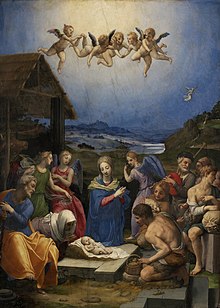Christmas-History of Christmas
Christmas-Where did Christmas start from?Whats the history of christmas?Look below here in this article to know the history of Christmas and its start and some pictures that would give you some basic ideas. These are the collected information from wiki. ----Look out for more information on Christmas, history of christmas, christmas holiday,christmas carol,christmas cake,christmas santa,christmas day,christmas tree,christmas songs,christmas ornaments,christmas words,christmas greetings,christmas ecard,christmas tradition,christmas poems,reindeer,xmas,christmas greeting cards,santa claus,christmas chords,silent night song,jingle bells,christmas sheet music,christmas tree ornaments,christmas mp3,christmas party,christmas toys,japanese christmas and much more information available only and only in www.christmas-santa.blogspot.com---- History Adoration of the shepherds (1535-40), by Florentine Mannerist painter Agnolo Bronzino Origin of holidayAlthough no one knows the exact date Jesus was born, Christians have favored December 25 since ancient times. It is the date on which the Romans marked the winter solstice and it is nine months following the Festival of Annunciation (March 25). In ancient and early Medieval times, Christmas was either a minor feast, or not celebrated at all. Around 220, the theologian Tertullian declared that Jesus died on March 25, AD 29, but was resurrected three days later. Although this is not a plausible date for the crucifixion, it does suggest that March 25 had significance for the church even before it was used as a basis to calculate Christmas. Modern scholars favor a crucifixion date of April 3, AD 33 (also the date of a partial lunar eclipse).[2] (These are Julian calendar dates. Subtract two days for a Gregorian date.) By 240, a list of significant events was being assigned to March 25, partly because it was believed to be the date of the vernal equinox. These events include creation, the fall of Adam, and, most relevantly, the Incarnation.[3] The view that the Incarnation occurred on the same date as crucifixion is consistent with a Jewish belief that prophets died at an "integral age," either an anniversary of their birth or of their conception.[4][5] Aside from being nine months later than Annunciation, December 25 is also the date the Romans marked the winter solstice, which they referred to as bruma. For this reason, some have suggested the opposite of the theory outlined above, i.e. that the date of Christmas was chosen to be the same as that of the solstice and that the date of Annunciation was calculated on this basis. (The Julian calendar was originally only one day off, with the solstice falling on December 24 in 45 BC. Due to calendar slippage, the date of the astronomical solstice has moved back so that it now falls on either December 21 or December 22.) The idea that December 25 is Jesus' birthday was popularized by Sextus Julius Africanus in Chronographiai (AD 221), an early reference book for Christians. This identification did not at first inspire feasting or celebration. In 245, the theologian Origen denounced the idea of celebrating the birthday of Jesus "as if he were a king pharaoh." Only sinners, not saints, celebrate their birthdays, Origen contended. In 274, Emperor Aurelian designated December 25 as the festival of Sol Invictus (the "unconquered sun"). Aurelian may have chosen this date because the solstice was considered the birthday of Mithras, a syncretic god of Persian origin. Mithras is often identified with Sol Invictus, although Sol was originally a separate Syrian god.  Mural painting of Jesus from the catacombs of Rome, late 4th century. Mithras was a god of light and a child of the earth who sprang up next to a sacred stream. He was born bearing a torch and armed with a knife. Sundays were dedicated to Mithras and caves were often used for his worship. A series of emperors promoted Mithraism beginning with Commodus. The cult emphasized loyalty to the emperor and Roman soldiers were expected to participate. Mithraism collapsed rapidly after Constantine I withdrew imperial favor (312), despite being at the peak of its popularity only a few years earlier. As Constantine ended persecution, Christians began to debate the nature of Christ. The Alexandrian school argued that he was the divine word made flesh (see John 1:14), while the Antioch school held that he was born human and infused with the Holy Spirit at the time of his baptism (see Mark 1:9-11). A feast celebrating Christ's birth gave the church an opportunity to promote the intermediate view that Christ was divine from the time of his incarnation.[6] Mary, a minor figure for early Christians, gained prominence as the theotokos, or god-bearer. There were Christmas celebrations in Rome as early as 336. December 25 was added to the calendar as a feast day in 350.[6] ----Look out for more information on Christmas, history of christmas, christmas holiday,christmas carol,christmas cake,christmas santa,christmas day,christmas tree,christmas songs,christmas ornaments,christmas words,christmas greetings,christmas ecard,christmas tradition,christmas poems,reindeer,xmas,christmas greeting cards,santa claus,christmas chords,silent night song,jingle bells,christmas sheet music,christmas tree ornaments,christmas mp3,christmas party,christmas toys,japanese christmas and much more information available only and only in www.christmas-santa.blogspot.com---- |

Comments on "Christmas-History of Christmas"
post a comment